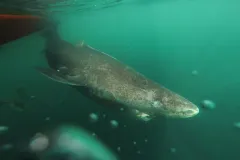In the Eyes of One Shark, Age is Nothing to Fear

In the freezing waters of the Arctic a toothed leviathan – the Greenland shark - claims an impressive feat. It now holds the record for longest documented lifespan of any vertebrate. The new discovery points to an age of roughly 400 years, meaning that some sharks swimming in today’s Arctic ocean may have shared the waters with explorers like Henry Hudson as he searched for the elusive Northwest Passage in the early 1600s.
Little is known about Greenland sharks, and even shark specialists see them as creatures of mystery. Perhaps it is their seemingly sluggish nature that has let them avoid the spotlight—their preferred swim pace, a leisurely 0.7 mph crawl, earned them the nickname sleeper shark. With little data and mostly anecdotal stories to characterize these massive fish, any new information about their life history helps us further understand this apex predator.

The Greenland shark prefers icy waters. They've been documented swimming in temperatures between 29 and 50 degrees Fahrenheit (-1.8 to 10 oC), in the Arctic and Northern Atlantic Oceans. Photo: Julius Nielson
Aging a Greenland shark proved tricky. Greenland sharks lack calcified bones or hard cartilage, instead finding support in skeletons of soft, flexible cartilage. Much like the rings of a tree, bones show visible lines that distinguish years of life. A person just has to count the rings to determine the bone’s (and by extension the animal’s) age. But a Greenland shark’s skeleton is too soft to show growth rings. Without hard skeletons to examine, the scientists needed to brainstorm to come up with more creative methods. The answer came from an unlikely source: the medical examiner’s office.
Forensic scientists employ an aging method in humans that takes advantage of the crystalline structure of the eye lens. Lens proteins are unique—isolated from blood vessels, they do not degrade and are never replaced by new proteins, unlike what happens in most structures in the body. Once a lens is formed in the womb its initial inner structure is essentially frozen in time. Scientist’s can take this snapshot of the conditions during development and use molecular dating techniques to determine when the lens was formed.
Using a method called radiocarbon dating, the scientists measured amounts of carbon-14 (a slightly radioactive form of carbon that is present in all living things) in each of the shark’s eyes that they sampled between 2011 and 2013. Along the recent historical timeline are key reference points for assigning dates, like the dropping of the atomic bombs and an increase in nuclear testing at the conclusion of World War II. Presence of a “bomb spike”, or significant increase in carbon-14, meant the shark was born before the 1960s. Only the three smallest of the sharks studied lacked the telltale bomb spike. The other 25 were aged with an aging curve based on known carbon-14 decay rates and the sizes of the sharks.

Researchers handle a Greenland Shark on the back deck of their research vessel. Photo: Julius Nielson
The largest shark, a 16-foot giant, was aged at 392 years. Given a considerable amount of uncertainty in the approximation, the age could be anywhere between 272 and 512 years. However, even the lower estimate would firmly place the Greenland shark as the oldest vertebrate—the bowhead whale, the previous record holder, only reaches ages of roughly 211 years. The older approximation would place the shark’s birth year at 1504—the year Michelangelo finished the sculpture David.
Such an age places Greenland sharks as prime witnesses to recent history. Just as today’s giants swam with explorers, pilgrims and colonizers, they also evaded the nets, long lines and trawlers from the height of the shark oil industry at the turn of the twentieth century. Even though an active fishery of Greenland sharks ended in 1910, Greenland shark populations may still be hurting from the practices. This dating method indicates that Greenland sharks attain sexual maturity at roughly 156 years old. This means that sharks born in the 1860s, when Iceland exported 13,100 barrels of shark oil in a year, would only now be first-time mothers. Any shark that was killed in its first 150 years of life never reproduced, and those born after the pressure from the active fishing industry still have half a century before they will contribute to restocking the population.
This discovery will be critical to future conservation assessments considering Greenland sharks are still caught and sold to supply Chinese markets and as a delicacy in Iceland. There has yet to be a scientific assessment of current population size, and the only understanding of relative population sizes come from the shark oil industry landings from the mid-twentieth century and anecdotal bycatch rates from today’s fisherman. Even more significantly, this discovery could hold clues to defying aging. Scientists are very curious to see the inner workings of a Greenland shark’s cells and hope to one day unlock their anti-aging machinery and apply it to humans.
But for now, it is easy to set aside the implications and simply relish the amazing fact that a shark swimming in the ocean was born nearly 400 years ago.

